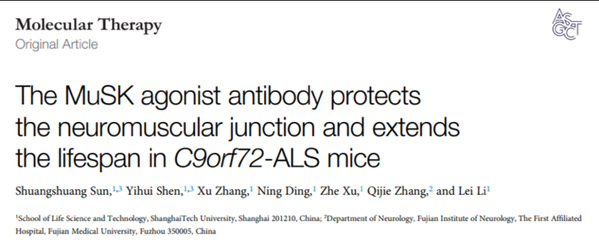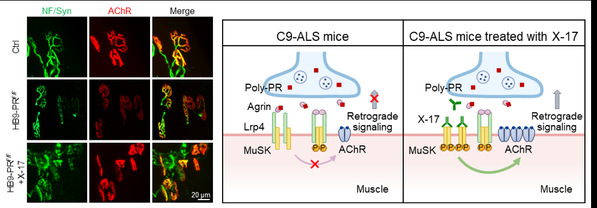Amyotrophic lateral sclerosis (ALS) is a severe neurodegenerative disease. Patients experience muscle weakness, paralysis, and atrophy due to the degeneration and death of both upper and lower motor neurons, eventually leading to breathing difficulties and death. Unfortunately, there is currently no effective treatment for this disease, and patients typically die within 3-5 years after diagnosis.
Assistant Professor Li Lei’s group in the School of Life Science and Technology (SLST) has been dedicated to exploring the pathological mechanisms of neurodegenerative diseases. In their recent study, the researchers revealed a new mechanism of neuromuscular junction deficits in ALS and discovered a novel therapeutic strategy. The results were published in a paper entitled “The MuSK agonist antibody protects the neuromuscular junction and extends the lifespan in C9orf72-ALS mice” in the journal Molecular Therapy in May.

The primary function of motor neurons, particularly lower motor neurons located in the spinal cord, is to transmit signals to muscles, controlling their contraction. The structure responsible for transmitting signals from motor neurons to muscles is known as the neuromuscular junction (NMJ). Abnormalities in the structure and function of the NMJ are the main reasons for the loss of motor function in ALS patients. These functional abnormalities typically occur early in the disease, long before motor neuron death. However, the reasons behind neuromuscular junction dysfunction in ALS patients are still not well understood.

Abnormal NMJ function in the early stages of ALS can lead to neurodegeneration.
This study discovered that the new mechanism causing structural and functional abnormalities of the neuromuscular junction in the C9orf72-ALS mouse model is due to motor neurons secreting poly-PR proteins, which inhibit the sustained activation of MuSK signaling essential for maintaining the neuromuscular junction. Interestingly, injecting a MuSK agonist monoclonal antibody into the ALS mouse model improved the structure and function of the neuromuscular junction, enhanced the motor abilities of the mice, and extended their lifespan. This demonstrated the potential of MuSK antibodies as a new therapeutic strategy for ALS. Since neuromuscular junction defects, particularly muscle denervation, are an early manifestation in all ALS patients, this therapeutic strategy could have potential applications for a wide range of ALS patients.

Schematic illustration of MuSK antibody improving the phenotype in the C9orf72-ALS mouse model.
PhD candidates Sun Shuangshuang and Shen Yihui from Prof. Li Lei’s group, are the co-first authors of the paper. Prof. Li Lei, and Dr. Zhang Qijie from the First Affiliated Hospital of Fujian Medical University, are the corresponding authors. ShanghaiTech University is the primary affiliation.
*This article is provided by Prof. Li Lei

